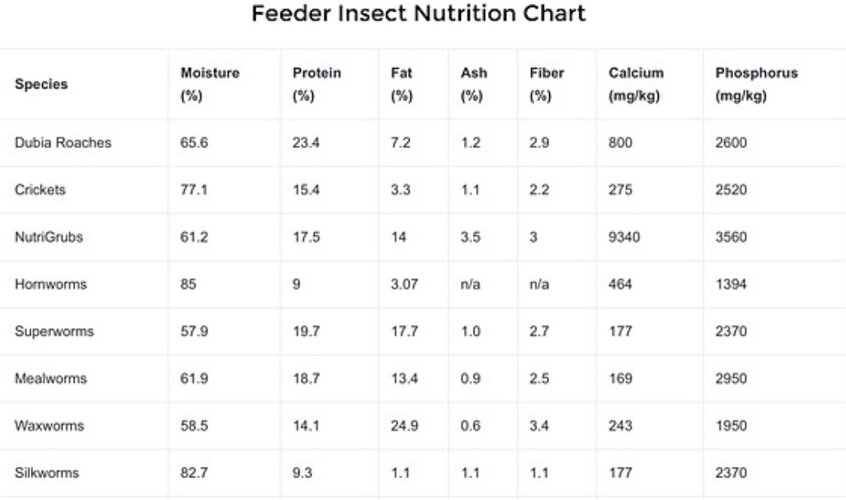Navigation
Install the app
How to install the app on iOS
Follow along with the video below to see how to install our site as a web app on your home screen.
Note: This feature may not be available in some browsers.
More options
You are using an out of date browser. It may not display this or other websites correctly.
You should upgrade or use an alternative browser.
You should upgrade or use an alternative browser.
Dusting question…grasshoppers
- Thread starter Kx2+cham
- Start date
I do not feed hoppers but everything I have ever read has only mentioned BSFL being ok not to dust because they have a high calcium ratio. The purpose of dusting is to balance out the phosphorus to calcium ratio of the insects. Lightly dusting insects does not hurt the chameleon. Not dusting however can.
crosscutts
Chameleon Enthusiast
Yes . and exactly what Beman says.To those who feed their cham hoppers, do you still dust them like crickets?
TIA
No worries. That is what the forum is here for. Always better to confirm then just try something that might not be a good thing for your cham.Thank you! Just making sure I am doing what supposed to be done. I’m new to chameleon and new to feeding grasshoppers.
Chameleon_mama
Member
I also heard this about silkies? That they’re high in calcium so don’t need to be dustedI do not feed hoppers but everything I have ever read has only mentioned BSFL being ok not to dust because they have a high calcium ratio. The purpose of dusting is to balance out the phosphorus to calcium ratio of the insects. Lightly dusting insects does not hurt the chameleon. Not dusting however can.
So from my understanding this would be incorrect. We dust to balance the calcium to phosphorus levels of the insect. If you look below Nutrigrubs are BSFL. See how the calcium level is 3 times the phosphorus? That is why we do not have to dust them. If you look at all other feeders the calcium level is a fraction of the phosphorus level and this is why we have to dust these to try to balance that calcium to phosphorus level back out. If you look at silkworms their calcium to phosphorus level is really low and unbalanced. So you would need to dust them as well.I also heard this about silkies? That they’re high in calcium so don’t need to be dusted

Chameleon_mama
Member
Oooh this is a helpful table. Where did you find it?So from my understanding this would be incorrect. We dust to balance the calcium to phosphorus levels of the insect. If you look below Nutrigrubs are BSFL. See how the calcium level is 3 times the phosphorus? That is why we do not have to dust them. If you look at all other feeders the calcium level is a fraction of the phosphorus level and this is why we have to dust these to try to balance that calcium to phosphorus level back out. If you look at silkworms their calcium to phosphorus level is really low and unbalanced. So you would need to dust them as well.
View attachment 345865
I actually do not know.Oooh this is a helpful table. Where did you find it?
SauceGandhi
Avid Member
Many of these numbers are questionable. I don't know about this one specifically, but dubia roach companies made charts like these, skewed in their favor, to boost sales. I noticed that sources were often missing or not scientific at all, but no one bothers to check (understandable, we don't have infinite time). Some of it could be completely made up  . It would probably be a good idea to make our own chart with proper sources from the scientific literature.
. It would probably be a good idea to make our own chart with proper sources from the scientific literature.
If you decide to make one..... Then you know we would love it.Many of these numbers are questionable. I don't know about this one specifically, but dubia roach companies made charts like these, skewed in their favor, to boost sales. I noticed that sources were often missing or not scientific at all, but no one bothers to check (understandable, we don't have infinite time). Some of it could be completely made up. It would probably be a good idea to make our own chart with proper sources from the scientific literature.
@SauceGandhi was that a no? lol I mean we would really love it. So much  Maybe we could incorporate it into the member resources section too.
Maybe we could incorporate it into the member resources section too.
SauceGandhi
Avid Member
We'll make it happen 
Yayyyyyyyy When you get it done message @JacksJill @Brad and myself. I am so excited that we will have an accurate chart within the forum for feeder values. You are awesome!We'll make it happen
Kx2+cham
Established Member
I think I’ve heard you mentioned this during Bill’s podcast interview or maybe read it before. If you can come up with an unbiased and science based feeder nutritional value chart the community will really appreciate it. I hope you can squeezed in doing the research in your busy schedule. Good luck!Many of these numbers are questionable. I don't know about this one specifically, but dubia roach companies made charts like these, skewed in their favor, to boost sales. I noticed that sources were often missing or not scientific at all, but no one bothers to check (understandable, we don't have infinite time). Some of it could be completely made up. It would probably be a good idea to make our own chart with proper sources from the scientific literature.
elizaann2
Chameleon Enthusiast
I’d love to see one as well!Yayyyyyyyy When you get it done message @JacksJill @Brad and myself. I am so excited that we will have an accurate chart within the forum for feeder values. You are awesome!






